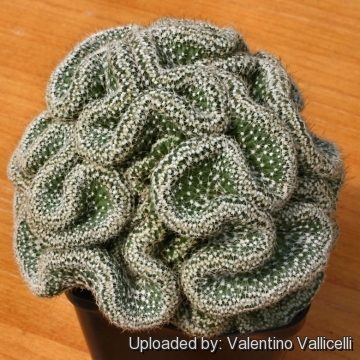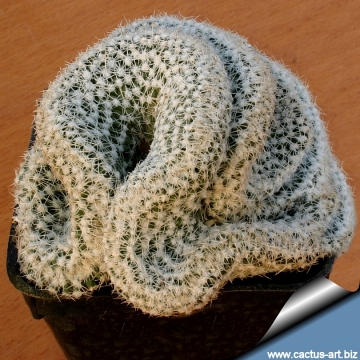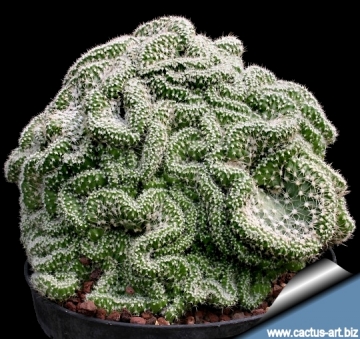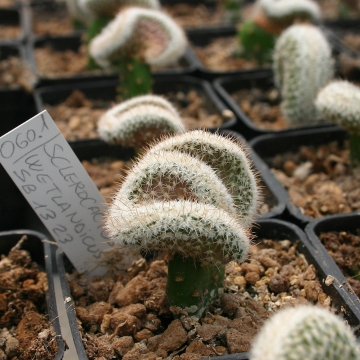
Sclerocactus wetlandicus f. cristata Photo by: Valentino Vallicelli
This plant forms huge specimens when grafted on a very short Opuntia compressa stock. (it don't do well on its own roots because rot very easily)
: Garden origin (Nursery produced cultivar)
:
: Sclerocactus wetlandicusSN|13869]]SN|13869]] is a rare north American cactus with central spines not greatly different from radial spines. The crested form Sclerocactus wetlandicusSN|13869]]SN|13869]] f. cristata is a strong and fast growing but often short lived plant. There are several clones some thin with white, bristly juvenile spines and other thick stemmed whit mature long hooked spines.
Stem: Fan shaped, green to bluish green (glaucous) 5-4o mm thick (depending on clones).
Ribs: Tubercles evident on ribs.
Areoles: 3 mm in diameter, 9-10 mm apart. Red nectar glands are found above each areole.
Spines: Slightly or not obscuring stems.
Radial spines: 6-10(or more) per areole, white, creas, pale tan, brown, reddish brown (rarely black), 6-20 mm, central spines 3-5 per areole, sometimes not greatly different from radial spines; straight and unhooked or curved (rarely hooked), 12-26 mm long. Juvenile specimens has pure white short bristly spines all radials.
Central spines: 3-4(-5) per areole, sometimes not greatly different from radial spines, usually white (rarely light brown), 15-29 mm long. Some specimens lack central spines, or have central spines which are hooked.
Flowers: Purple or pink flowers fragrant, funnel-form, 2,5-5 cm wide and tall; outer tepals with brownish lavender midstripes and pink to violet margins, filaments green to white; anthers yellow.
Fruits: Ovoid, barrel-shaped, 9-30 long, 7-12 mm across, with a few membranous scales, mostly near apex.
Seeds: Black, 1,5 long, 2,5 mm broad; cells convex but flattened apically.
Blooming season: Spring (In habitat from late April to May).
: Major references and further lectures
1) James Cullen, Sabina G. Knees, H. Suzanne Cubey “The European Garden Flora Flowering Plants: A Manual for the Identification of Plants Cultivated in Europe, Both Out-of-Doors and Under Glass” Cambridge University Press, 11/Aug./2011
2) David Hunt, Nigel Taylor “The New Cactus Lexicon” DH Books, 2006
3) Edward F. Anderson “The Cactus Family” Timber Press, 2001
4) Sclerocactus wetlandicus in: “Flora of North America North of Mexico, vol. 4: Magnoliophyta: Caryophyllidae, part. 1” Oxford University Press New York, New York, USA
5) Sclerocactus wetlandicus in: http://www.efloras.org/florataxon.aspx?flora_id=1&taxon_id=242415287 downloades on 20/08/2013
 Sclerocactus wetlandicus f. cristata Photo by: Valentino Vallicelli
Sclerocactus wetlandicus f. cristata Photo by: Valentino Vallicelli Sclerocactus wetlandicus f. cristata Photo by: Cactus Art
Sclerocactus wetlandicus f. cristata Photo by: Cactus Art Sclerocactus wetlandicus f. cristata Photo by: Cactus Art
Sclerocactus wetlandicus f. cristata Photo by: Cactus Art Sclerocactus wetlandicus f. cristata Photo by: Cactus Art
Sclerocactus wetlandicus f. cristata Photo by: Cactus Art Sclerocactus wetlandicus f. cristata Photo by: Cactus Art
Sclerocactus wetlandicus f. cristata Photo by: Cactus Art
: Although regarded as a choice and difficult plant is not too difficult in a greenhouse, although grows quite slowly.
Soil: Use mineral well permeable mineral soil without or with very little organic matter (peat, humus).
Exposure: They need a good amount of light shade to full sun this help to keep the plants healthy, although slow growth.
Watering: Water sparingly from March till October, if the weather is sunny enough. No water during cold winter months, or when night temperatures remain below 10° to prevent root loss. It is very sensitive to overwatering (rot prone).
Fertilization: Feeding may not be necessary at all if the compost is fresh then, feed in summer only if the plant hasn't been repotted recently. Do not feed the plants from September onwards as this can cause lush growth which can be fatal during the darker cold months.
Hardiness: Keep perfectly dry in winter at temperatures from 5 to 15 degrees centigrade. (but it is relatively cold resistant and hardy to -15° C, or possibly colder for short periods) In the rest period no high atmospheric humidity!! (Temperature Zone: USDA 8-10)
Propagation: Grafting or cuttings. Plants are usually grafted onto column-shaped cacti but proved to be able to produce their own roots if degrafted. Cuttings will root better in hot weather. Cuttings must be kept quite dry to root and must be placed on the soil surface without burying the plant base down in the soil.
















